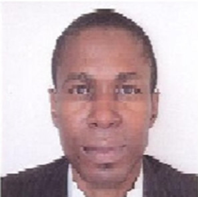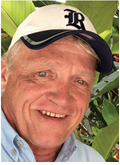Day 2 :
Keynote Forum
Chinedum Onyemechi
Federal University of Technology Owerri, Nigeria
Keynote: Ocean research institutional model for the emerging sector: West Africa’s subsea support sector

Biography:
Chinedum Onyemechi is an accomplished academic with over eighty published works in Maritime Management Technology most of which has been presented in academic and industry-based conferences in countries including but not limited to United Kingdom, Egypt, South Africa, United States of America, Canada, India, Spain, Russia, and Nigeria. He was promoted Lecturer II in 2006 and Lecturer I in 2009. He became a Senior Lecturer in the year 2012 and has been promoted
Reader in the professorial cadre ‘Maritime Management Technology’ in the year 2015.
Abstract:
The work analyzed current level of development in deep-sea ocean technology research in juxtaposition with present level of ocean technology research in West Africa and came up with solutions on research development pathway for the entire region. Given West Africa’s position as current leader in deep-sea oil production in Africa the need for the gearing of her local content in this direction was stressed. Theoretical models discussed in the course of the research includes direct ocean engineering models such as linear wave theory, second-order Stokes wave theory, the stream function theory, and spectrum models. These models were further assessed in terms of current applications in the design of West Africa’s floating, production and storage vessels. Further analyzed were institutions in West Africa with good research laboratories for ocean technology research using such models as the ecosystems model and the diamond cluster model. Solutions were derived at the end of the study and recommendations made for West Africa’s offshore sub sector.
Keynote Forum
James H Cowan
Louisiana State University, USA
Keynote: Fisheries and their impacts: Imagined and real

Biography:
James H Cowan, Jr is a Professor in the Department of Oceanography and Coastal Sciences and the Coastal Fisheries Institute at the Louisiana State University, both of which are part of LSU's School of the Coast and Environment. He received BSc (Biology) and MSc (Biological Oceanography) degrees from Old Dominion University, and MSc (Experimental Statistics) and PhD (Marine Sciences) degrees from the Louisiana State University. Among many other professional activities, he has served on four National Research Council study committees and technical review panels concerning fisheries issues, has twice served on the Ocean Sciences Division, Biological Oceanography Review Panel for the National Science Foundation, and has served as a US delegate both to the International Council for the Exploration of the Sea (ICES) and the Pacific Marine Sciences Organization (PICES). He was Chairman of the Reef Fish Stock Assessment Panel for 13 years and
currently is a member of the Standing Scientific and Statistical Committee for the Gulf of Mexico Fishery Management Council. He has served as President of the Early Life History Section, and on the Outstanding Chapter Award and Distinguished Service Award committees for the American Fisheries Society.
Abstract:
The impacts of harvest on fisheries have been hotly debated over the past 100 years. Here, I discuss these impacts, both imagined and real. The first part of my talk will focus on Pauly’s Mean Trophic Level Index, which is meant to provide a means by which to identify whether fisheries ecosystems have declined in complexity, owing mostly to the overharvest of large pelagic predators. Pauly suggested in a 1998 paper in Science that many of the world's fisheries ecosystems are threatened by these removals, thus reducing long-term stability and productivity. I will provide an example from the Gulf of Mexico to both illustrate and question the validity of this Index. In the second part of my talk, I will discuss the magnitude and effects of bottom trawling, a fishing technique that has been used since the early 1800’s and continues today to be used worldwide. I will speak about the effects of trawls on fish and crustacean populations, and on the seafloor. Often, trawling is focused on a single species, but trawls are notoriously nommed selective, and those fishes or crustaceans that aren’t the target species are returned to the sea dead. In the early days of trawling for shrimp in the Gulf of Mexico, the ratio of pounds of bycatch to pounds of shrimp was ~11:1. In a new paper that has been submitted for publication, we estimated the area of the northern Gulf of Mexico shelf and slope to a depth of 1000 m are approximately 4.6×105 km2. The total trawl swept-area for the years 2007-2009 was 2.8×105 km2 yr-1 making impacts of trawling easy to visualize. When all of the areas we studied are combined, landings of fish, crustaceans, and mollusks are 18.9 to 19.8 million t yr-1.
- Physical Oceanography | Fisheries Oceanography | Marine Geology and GIS Application | Marine Pollution | Marine Ecology | Marine Biology | Marine Chemistry | Coastal Ecology
Location: Dallas

Chair
Michel Denis
Université d’Aix-Marseille, France

Co-Chair
Miguel De Luque Villa
Universidad de Cundinamarca, Colombia
Session Introduction
Germán Daniel Rivillas Ospina
Universidad Del Norte, Colombia
Title: Port development and coastal modifications: Barranquilla Port, Colombia

Biography:
German Daniel Rivillas Ospina profile is based on hydraulics and coastal engineering topics. He has ten years of experience on hydraulic and coastal projects with technical and investigation interest, in order to understand the physical problems that affect the ecosystems and to promote restoration solutions. Since 2012 he is doing research in coastal erosion and coastal wetlands restoration, in order to reduce the anthropogenic impacts. Structural solutions are evaluated to implement restoration measures and encourage the growth of the resilience of the coastal zone.
Abstract:
The aim of this research is focused on the application of a methodology to assess erosive processes in Colombian Caribbean coastal wetlands. The analyses of the coastal bar that separate the lagoon from the sea, as well as the diagnostic process that helps to characterize the effect of the coastal infrastructure in coastal zones in a short and medium scale, was done. Geomorphology, wave climate, hydrodynamic and evolution of the coastline topics was taking into account to understand “Mallorquín” coastal wetland equilibrium. The degradation level assessment shows that slightest changes in physics conditions produce adverse effects and system modifications. This work describes a procedure to understand the relationship between alterations of coastal processes and the response of a coastal environment against anthropogenic modifications due to navigation activities that exacerbate the coastal equilibrium losses. The procedure uses numerical and theoretical models to evaluate the behavior of the local hydrodynamic, considering the coastline evolution that has occurred, in order to establish a baseline to predict variations of the coastal bar as consequence of the establishment of Barranquilla port development. The results show that the coastal zone will be affected by the works to be developed for facilitating the navigability conditions of a new port in the city of Barranquilla, Colombia.

Biography:
André Droxler is a carbonate sedimentologist, marine geologist, paleo-oceanographer and climatologist with interests in reef and carbonate evolution at different time scales, ad in past ocean climate and sea-level changes. He is an expert on reefs and carbonate platforms from the Cambrian to the Holocene.
Abstract:
This study focuses on the last 1500 yr. precipitation record and tropical storm occurrence, archived in the sediments from the Belize Central Shelf and the Blue Hole of Lighthouse Reef, proximal to the land areas where the Mayan Urban Civilization thrived and then abruptly collapsed. Cores were retrieved in 30 and 19 mbsl (meters below sea level) from Elbow Caye Lagoon and English Caye Channel, respectively, in addition to cores retrieved from the anoxic bottom sediment of the Blue Hole at 120 mbsl. The core timeframe is constrained by AMS radiocarbon dating of benthic foraminifera and organic residues, in addition to varve counts. Element (Ti, Si, K, Fe, Al, Ca, and Sr) counts were quantified via X-Ray Fluorescence. The records of Ti and K counts, and Ti/Al in these two cores have recorded, in the past 1500 years, the variable weathering rates of the adjacent Maya Mountain, defining alternating periods of high precipitation and droughts, linked to large climate fluctuations and extreme events, highly influenced by the ITCZ latitudinal migration. Coarse sediment layers in the upper part of the Blue Hole cores were correlated with historical tropical cyclones. The CE 800-900 century just preceding the Medieval Climate Anomaly (MCA), characterized by unusually low Ti counts and Ti/Al, and tropical cyclone scarcity, is interpreted to represent a time of low precipitation and resulting severe droughts in the Yucatan Peninsula, contemporaneous with the Mayan Terminal Classic Collapse. High Ti counts and Ti/Al, although highly variable, during the MCA (CE 900-1350), are interpreted as an unusually warm period characterized by two 100-to-250 years-long intervals of higher precipitation when the number of tropical cyclones peaked. These intervals of high precipitation are separated by a century (CE 1000 -1100) of severe droughts and rare tropical storm coinciding with the collapse of Chichen Itza (CE 1040-1100).

Biography:
Maksim Koval graduated from the Far East Technical University of Fishery Industry (Vladivostok, Russia) in 1994 (specialties: hydrobiology and ichthyology). Same year began to work in Kamchatka Research Institute of Fisheries and Oceanography (KamchatNIRO, Petropavlovsk-Kamchatsky). In 1994-2011 was participant and coordinator of marine research expeditions in offshore and coastal water of the North Pacific and the Far East Seas (including international cruises under North Pacific Anadromous Fish Commission programs). In 2007 has defended a PhD with the dissertation “Forage base and feeding particularities of Pacific salmon in the Kamchatkan waters of the Okhotsk and Bering seas and in the northern part of the Pacific Ocean”. Since 2012 main research project: Ecology of Coastal, Estuarine and Freshwater Ecosystem of the Kamchatka.
Abstract:
New data on the abiotic conditions; species composition; abundance, distribution, and migrations of fauna; and feeding interactions in an estuary ecosystem were obtained during expeditions in the mouths of Penzhina and Talovka rivers (Northwest Kamchatka), June-September 2014-2015. It is revealed that in the ice-free season, the hydrological regime of the estuary is determined by seasonal fluctuations of river runoff, as well as fortnightly and daily variation of tides. The estuary is characterized by hypertidal fluctuations (up to 10–12 m); strong reverse flows (up to 1.0–1.5 m/s), considerable tidal variations in salinity (from 0 to 6–9‰ at the river boundary and from 6–8 to 14–16‰ at the offshore boundary), and high water turbidity (up to 1 000 NTU or more). Based on the spatial structure of the community, three ecological zones with mobile boundaries are distinguished: freshwater (salinity 0–0.1‰), estuarine (0–12.3‰), and neritic (11.2–18.9‰). High turbidity prevents the development of phytoplankton in the estuarine zone (EZ), and the local benthic community is significantly depleted due to the desalination and widespread of aleuritic silts. Neritic copepods and nektobenthic brackish-water crustaceans generate the maximum abundance and biomass here. The species that have adapted to the local extreme hydrologic conditions dominate and form the basis of the estuarine food chain. Dominant among the EZ vertebrates are such groups as anadromous fishes (smelts, pacific salmons, charrs, and sticklebacks); waterfowl (terns, kittiwakes, cormorants, fulmars, puffins, guillemots, auklets, and wadepipers); and predatory marine mammals (larga, ringed seal, bearded seal, and white whale). The total abundance and biomass of these animals are much higher in the pelagic EZ in comparison to neighboring zones. The scheme of the food web of the Penzhina and Talovka hypertidal estuary was constructed.

Biography:
Andrew Ziegwied is the Scientific Sales Manager for Autonomous Surface Vehicles LLC (ASV Global), a small US business headquartered in Broussard, Louisiana. ASV Global is the leading designer, manufacturer and operator of high-performance, rugged, force multiplying Autonomous Surface Vehicle systems delivering multi-domain capable unmanned and autonomous systems for research, survey, surveillance, and defense applications. Andrew is a University of Washington School of Oceanography graduate with extensive government and commercial consulting experience providing integrated instrumentation solutions with the international MacArtney Underwater Technology Group. His background also includes field work and project management with Evans-Hamilton, Inc. (Now RPS) and application engineering with instrument manufacturer Sea-Bird Electronics, Inc. (Now Sea-Bird Scientific).
Abstract:
Statement of the Problem: A number of measurement systems are commonly employed to autonomously monitor the ocean conditions in the outer continental shelf to support energy development, military activities, shipping and other key Blue Economy industries. These methods are frequently limited by satellite orbits, sensor resolution, and atmospheric conditions. This problem becomes acute for obtaining reliable data on smaller meoscale features such as the frontal eddies (LCFE) along current systems. Satellite-tracked Lagrangian drifters are often combined with remote sensing data to track and measure currents. The limited drifter residency within features of interest creates gaps in coverage and necessitates regular drifter replacement. Acoustic Doppler Current Profilers (ADCPs) have been deployed into the GOM on many deepwater moorings, offshore platforms, and mobile drilling units (MODU), but these systems remain sparsely distributed and operate intermittently. There are a growing number of high frequency radar systems in use for observing coastal circulation, but their horizontal range and up-time are limited to shelf waters. And evolving industries, such as offshore wind, are just beginning to explore opportunities for collecting ocean data. The recent advances in autonomous surface vehicle (ASV) design, propulsion, software, and sensors have resulted in a proliferation of vehicles, including optionally manned conversions, for a multitude of missions. These technologies have created new opportunities to develop heterogeneous and collaborative unmanned systems based around smaller, lower-cost, unmanned surface, underwater and aerial vessels. We propose that diesel-electric powered ASVs with modular architectures can incorporate numerous interchangeable sensor payloads and allows one ASV unit to function as a multi-instrument platform to support other offshore operations. With over 30 days at 7 knots endurance capability and over the horizon communications, this technology represents a step change in offshore operations is a cost effective surrogate to the use of Regional Class Research/ Survey vessels to deliver the equivalent capability.
